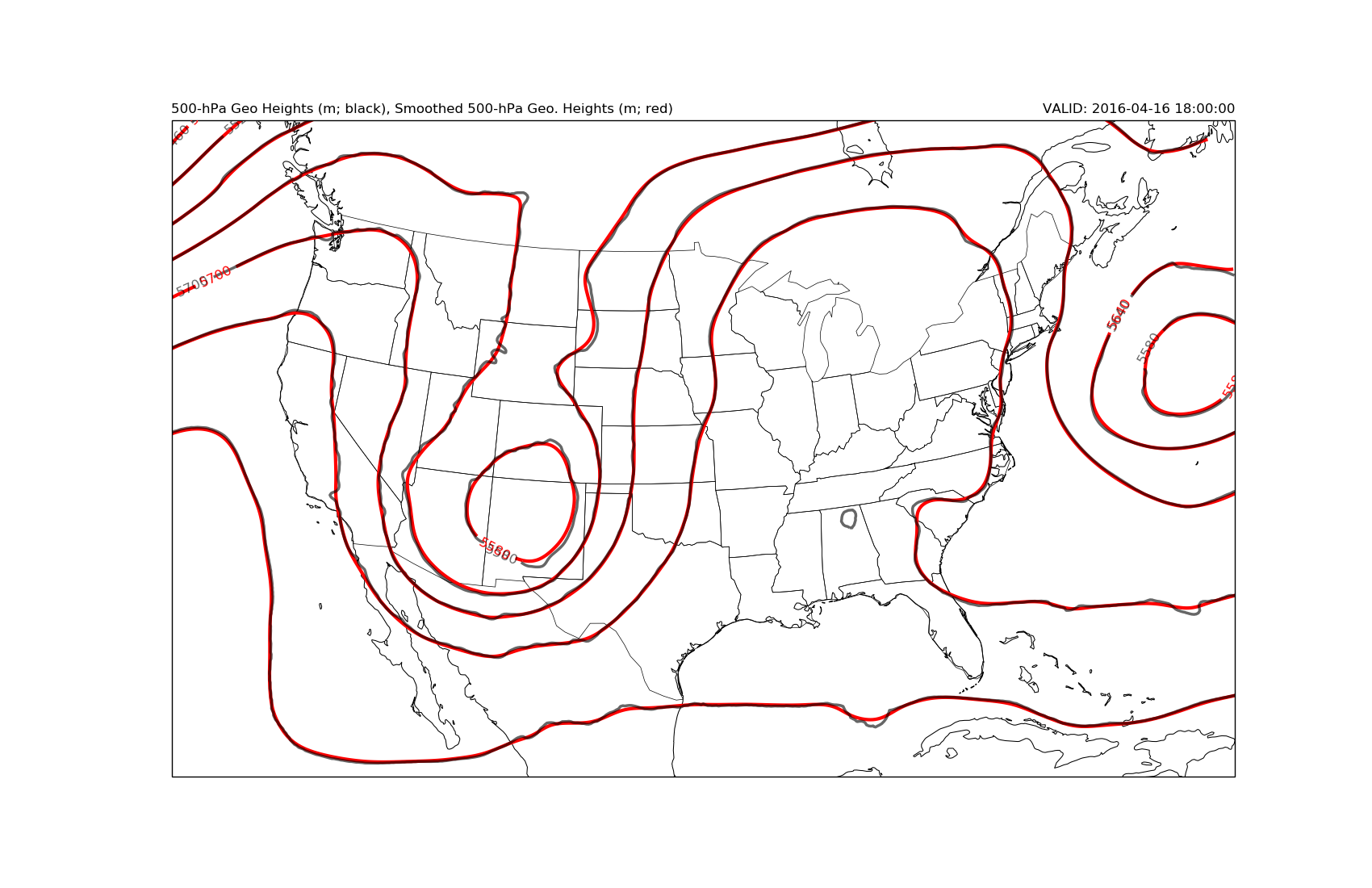Note
Click here to download the full example code
Smoothing Contours¶
Demonstrate how to smooth contour values from a higher resolution model field.
By: Kevin Goebbert
Date: 13 April 2017
Do the needed imports
Set up netCDF Subset Service link
dt = datetime(2016, 4, 16, 18)
base_url = 'https://www.ncei.noaa.gov/thredds/ncss/grid/namanl/'
ncss = NCSS('{}{dt:%Y%m}/{dt:%Y%m%d}/namanl_218_{dt:%Y%m%d}_'
'{dt:%H}00_000.grb'.format(base_url, dt=dt))
# Data Query
hgt = ncss.query().time(dt)
hgt.variables('Geopotential_height_isobaric', 'u-component_of_wind_isobaric',
'v-component_of_wind_isobaric').add_lonlat()
# Actually getting the data
data = ncss.get_data(hgt)
Pull apart the data
# Get dimension names to pull appropriate variables
dtime = data.variables['Geopotential_height_isobaric'].dimensions[0]
dlev = data.variables['Geopotential_height_isobaric'].dimensions[1]
dlat = data.variables['Geopotential_height_isobaric'].dimensions[2]
dlon = data.variables['Geopotential_height_isobaric'].dimensions[3]
# Get lat and lon data, as well as time data and metadata
lats = data.variables['lat'][:]
lons = data.variables['lon'][:]
lons[lons > 180] = lons[lons > 180] - 360
# Need 2D lat/lons for plotting, do so if necessary
if lats.ndim < 2:
lons, lats = np.meshgrid(lons, lats)
# Determine the level of 500 hPa
levs = data.variables[dlev][:]
lev_500 = np.where(levs == 500)[0][0]
# Create more useable times for output
times = data.variables[dtime]
vtimes = num2date(times[:], times.units)
# Pull out the 500 hPa Heights
hght = data.variables['Geopotential_height_isobaric'][:].squeeze() * units.meter
uwnd = units('m/s') * data.variables['u-component_of_wind_isobaric'][:].squeeze()
vwnd = units('m/s') * data.variables['v-component_of_wind_isobaric'][:].squeeze()
# Calculate the magnitude of the wind speed in kts
sped = mpcalc.wind_speed(uwnd, vwnd).to('knots')
Set up the projection for LCC
plotcrs = ccrs.LambertConformal(central_longitude=-100.0, central_latitude=45.0)
datacrs = ccrs.PlateCarree(central_longitude=0.)
Subset and smooth
# Subset the data arrays to grab only 500 hPa
hght_500 = hght[lev_500]
uwnd_500 = uwnd[lev_500]
vwnd_500 = vwnd[lev_500]
# Smooth the 500-hPa geopotential height field
# Be sure to only smooth the 2D field
Z_500 = ndimage.gaussian_filter(hght_500, sigma=5, order=0)
Plot the contours
# Start plot with new figure and axis
fig = plt.figure(figsize=(17., 11.))
ax = plt.subplot(1, 1, 1, projection=plotcrs)
# Add some titles to make the plot readable by someone else
plt.title('500-hPa Geo Heights (m; black), Smoothed 500-hPa Geo. Heights (m; red)',
loc='left')
plt.title('VALID: {}'.format(vtimes[0]), loc='right')
# Set GAREA and add map features
ax.set_extent([-125., -67., 22., 52.], ccrs.PlateCarree())
ax.coastlines('50m', edgecolor='black', linewidth=0.75)
ax.add_feature(cfeature.STATES, linewidth=0.5)
# Set the CINT
clev500 = np.arange(5100, 6000, 60)
# Plot smoothed 500-hPa contours
cs2 = ax.contour(lons, lats, Z_500, clev500, colors='red',
linewidths=3, linestyles='solid', transform=datacrs)
c2 = plt.clabel(cs2, fontsize=12, colors='red', inline=1, inline_spacing=8,
fmt='%i', rightside_up=True, use_clabeltext=True)
# Contour the 500 hPa heights with labels
cs = ax.contour(lons, lats, hght_500, clev500, colors='black',
linewidths=2.5, linestyles='solid', alpha=0.6, transform=datacrs)
cl = plt.clabel(cs, fontsize=12, colors='k', inline=1, inline_spacing=8,
fmt='%i', rightside_up=True, use_clabeltext=True)
plt.show()

Total running time of the script: ( 0 minutes 5.568 seconds)